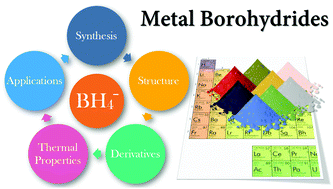Metal borohydrides and derivatives – synthesis, structure and properties
Abstract
A wide variety of metal borohydrides, MBH4, have been discovered and characterized during the past decade, revealing an extremely rich chemistry including fascinating structural flexibility and a wide range of compositions and physical properties. Metal borohydrides receive increasing interest within the energy storage field due to their extremely high hydrogen density and possible uses in batteries as solid state ion conductors. Recently, new types of physical properties have been explored in lanthanide-bearing borohydrides related to solid state phosphors and magnetic refrigeration. Two major classes of metal borohydride derivatives have also been discovered: anion-substituted compounds where the complex borohydride anion, BH4−, is replaced by another anion, i.e. a halide or amide ion; and metal borohydrides modified with neutral molecules, such as NH3, NH3BH3, N2H4, etc. Here, we review new synthetic strategies along with structural, physical and chemical properties for metal borohydrides, revealing a number of new trends correlating composition, structure, bonding and thermal properties. These new trends provide general knowledge and may contribute to the design and discovery of new metal borohydrides with tailored properties towards the rational design of novel functional materials. This review also demonstrates that there is still room for discovering new combinations of light elements including boron and hydrogen, leading to complex hydrides with extreme flexibility in composition, structure and properties.



 Please wait while we load your content...
Please wait while we load your content...